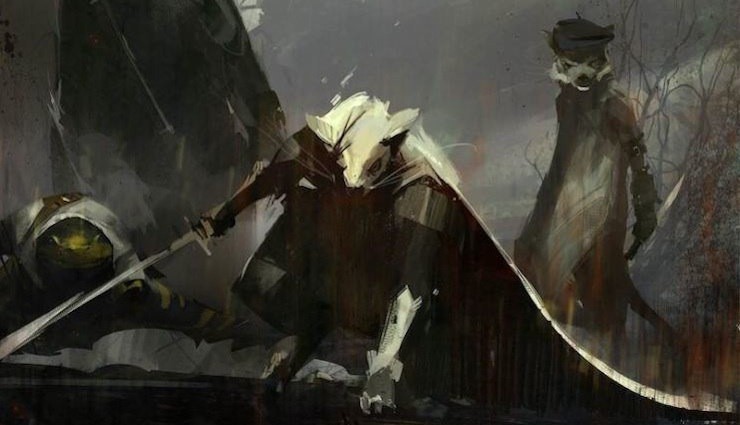Warrior mice, revolutionary pigs, scientifically-minded chimpanzees, and radioactive elephants—some of the most memorable (and ironically, the most human) stories feature anthropomorphic animals at their core. Political history, racial allegories, class tensions, and environmental warnings spring to life when ordinary animals are re-cast as, say, Leon Trotsky, or a heartsick sniper fighting an endless war…
Below, we’ve corralled some of the best animal characters genre fiction has to offer. Let us know your favorites in the comments!
Barsk: The Elephants’ Graveyard and The Moons of Barsk by Lawrence M. Schoen
Buy the Book
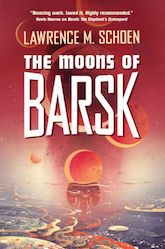

The Moons of Barsk
A fatherless boy named Pizlo is a member of the Fant—the race of anthropomorphic elephants that have been banished to Barsk, considered a backwater by the rest of the uplifted animals of the galaxy. Humans are a distant memory, but the various animal descendants have proved adept at populating space without our interference. Now an offworld group is trying to break into the Fant’s control of their one resource, a medicine called koph. While his voices push him toward an uncertain future, his father’s best friend, the Fant’s Speaker With the Dead, is using the spirits’ answers to uncover secrets that those in power would prefer to keep hidden. Here anthropomorphic animals and far-future sci-fi combine to tell a heartbreaking story of the elusiveness of truth, and the prison of memory.
Animal Farm by George Orwell
Buy the Book
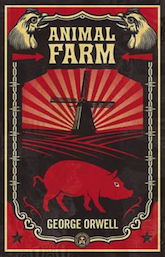

Animal Farm
Obviously, this one holds a place of honor on any list of talking animals. Orwell’s mini-allegory of the Bolshevik Revolution casts pigs as different members of the communist party, while the hardworking horses, cows, and hens stand in for the peasant class—exploited first by feudalism and then by the Party itself. The dogs, once loyal to the humans, become the pigs’ military over the course of a generation, while the sheep blindly follow whoever is in charge. Also, I’m pretty sure the donkey is supposed to be Walter Benjamin? Anyway, never trust anything that walks on two legs! And never give a pig liquor. It turns out that doesn’t end well.
The Island of Dr. Moreau by H.G. Wells
Buy the Book
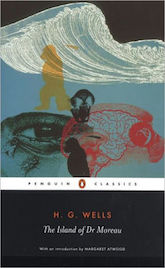

The Island of Dr. Moreau
Speaking of never trusting anything with two legs… poor Dr. Moreau just wants to be left in peace on his island, where he can genetically modify every animal he can get his hands on. Is it so wrong to want an army of Beast Folk? Unfortunately, the rest of the world isn’t so keen on the Beast Folk plan, so Moreau must pursue perfection alone. His latest experiment, a Puma-Man (ahem), also turns out not to be wholly onboard with his uplifting, and things go a bit pear-shaped. Did I mention that giving transformed animals liquor is a bad idea? Did that come through? Wells used this horrific tale as an attack on the practice of vivisection, as well as pointing out that humans seemed to be slipping a bit in their civilized ways.
The Only Harmless Great Thing by Brooke Bolander
Buy the Book
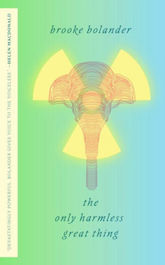

The Only Harmless Great Thing
In an alternate past, elephants are recognized as sapient creatures by their ability to communicate through a trunk-centric sign language called Proboscidian. That doesn’t stop the folks at US Radium from putting a troublesome Indian elephant to work in the factories alongside their female employees, who are slowly dying of radiation poisoning. In an alternate present shaped by a rewriting of Topsy’s tragic death at Coney Island, a young woman attempts to convince the elephants to change their genes and their very purpose in order to help prolong the human race. The fact that she doesn’t speak Proboscidian and must rely on a translator only underscores the exploitative relationship between the (as the poetic interludes describe it) “flat-faced pink squeakers with more clever thinking than sense” and the Many Mothers with “memories longer than stone.” Read an excerpt from the novella here.
The War with No Name Series by Robert Repino
Buy the Book
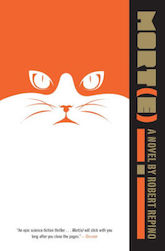

Mort(e)
One day, Morte is an ordinary housecat. He has a crush on a neighbor dog named Sheba, and he loves lying in the sun. But then things start to change. He begins to think more complex thoughts, and chafe against the restraints of life as a cat. Something terrible happens to Sheba’s puppies, and the dog disappears. Suddenly a new world is revealed, one ruled by the Colony, hyper-intelligent ants who want to eradicate the human race. Morte takes on a new role as a warrior, and seems to be dedicated to this new animal-friendly world. But his true motivations are more complicated than that, and when a human claims to know where Sheba is, Morte has to decide what he’s willing to risk for his friend. The book skillfully weaves a post-apocalyptic narrative into an allegory about human society, along with a dash of Unstoppable-Virus-That-Must-Be-Contained. The first two books in the series, Morte and D’Arc, find their true heart in the story of Morte’s unwavering interspecies love for Sheba, while the third Culdesac, follows the adventures of a murderous Bobcat.
The Builders by Daniel Polansky
Buy the Book
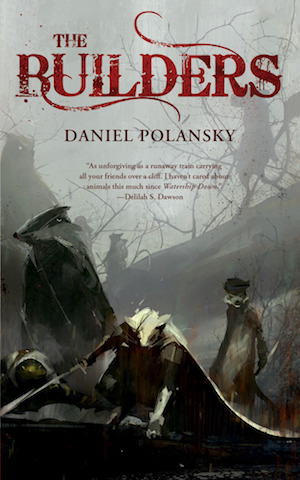

The Builders
A missing eye… a broken wing… a stolen country.
Yeah, the last job didn’t end well.
The Captain’s company has kept a low profile since then, eking out an existence in the shadow of the war they lost. But that doesn’t mean the memories have faded, or even that the wounds have scarred. It’s all still fresh to the Captain. He finally sees a shot at vengeance, but how many of his old company are left? And how many will join the old mouse on one last tour? Opossum sniper Boudica, stoat assassin Bonsoir, and the sinister salamander named Cinnabar all answer his call, but will they be enough to settle the score?
The Jungle Books by Rudyard Kipling
Buy the Book
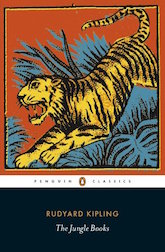

The Jungle Books
Rudyard Kipling’s stories of survival in the jungles of India have inspired several live-action movies (including one that stars Scarlett Johansson as Kaa, which, frankly, terrifies me) the classic Disney cartoon and, wonderfully, Neil Gaiman’s The Graveyard Book. At the heart of the stories is a man-cub named Mowgli who has to learn to live among various slightly anthropomorphized beasts, including Bagheera the regal panther, Baloo the slacker bear, and Shere Khan, the kick-ass tiger who is vilified for acting like a tiger. The book also includes the heroic tale of Rikki-Tikki-Taavi, so if you want to weep for a few straight hours, Kipling has you covered.
Saga by Brian K. Vaughan and Fiona Staples
Buy the Book
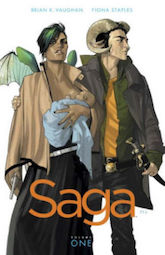

Saga Volume 1
The world of Saga includes plenty of magical beings, robots, and talking animals, but the one we truly love is Lying Cat. A giant blue space cat, she’s the companion to a bounty hunter known as The Will and helps him on his jobs by loudly announcing “LYING” whenever someone tries to evade the truth. She’s also a fairly effective enforcer, taking down armed men when necessary. Initially used as a sort of dark comic relief, Lying Cat won our hearts by providing comfort to Sophie, a young girl rescued from a particularly creepy pleasure planet. Later—because we can’t have nice things—we get a single, terrible panel of backstory that throws all of Lying Cat’s life into stark relief.
Tailchaser’s Song by Tad Williams
Buy the Book
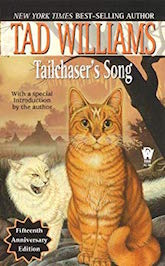

Tailchaser's Song
Tad Williams’ first novel follows a ginger tomcat named Fritti Tailchaser as he navigates life among other anthropomorphized animals, each with their own cultural traditions, mythologies, and languages. The epic begins when Tailchaser decides to leave the Meeting Wall clan and investigate the mysterious disappearances of cats. The journey soon becomes a full-fledged quest as he gains friends (including the adorably-named kitten Pouncequick, and the somewhat-less-adorably-named crazy cat, Eatbugs) and enemies as he followsthe path to the Royal Court. Tailchaser must face off with villainous Lord Hearteater and the dog-like monster Fikos to save his fellow cats from extinction.
Vic and Blood by Harlan Ellison
Buy the Book
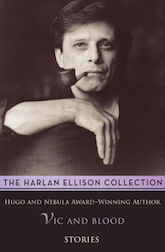

Vic and Blood
Harlan Ellison’s story cycle featuring Vic (the Boy) and Blood (the Dog) isn’t so much an allegory as it is a bleak postwar dystopia, but there is enough satire in the plot, and enough acidic running commentary from Blood, that we felt like it needed to be here. Vic is the child of scavengers, with no education and little sense of morality. He does what he needs to survive, and since puberty has recently struck, he also does whatever he needs to find women, whether they’re willing or not. He and Blood develop a symbiotic relationship—Blood smells out women, and Vic steals food to share. L.Q. Jones’ 1975 movie adapts the second story in the cycle. Now, you’re going to be shocked by this, but Harlan Ellison voiced some disagreements that he had with the film adaptation, particularly calling out the “moronic, hateful, chauvinist” final line.
Mouse Guard by David Petersen
Buy the Book
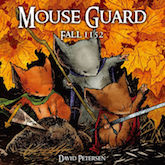

Mouse Guard Volume 1: Fall 1152
Mouse Guard is a long-running comic series about a blissfully human-free medieval world, and the complex society built by sentient mice. The mice managed to overthrow an evil weasel and live in relative peace, and the “Mouse Guard” formed as a brotherhood to protect civilians from other predators, escorting them as they travel through lands that may be unsafe.
The Mouse Guard is made up of a vast array of characters, from Gwendolyn, the leader who oversees the MG’s operations to her assistant Roibin (who is also a poet), to Celanawe, The “Black Axe,” whose prowess in battle has passed into legend, to Sadie, a younger mouse who returns home from the Guard outpost on the Easter Shores with a terrifying skill with daggers. The books riff on the conventions of medieval adventure, while creating a portrait of a complex society that can contain both brutal violence and adorable whiskers.
Carmen Dog by Carol Emshwiller
Buy the Book
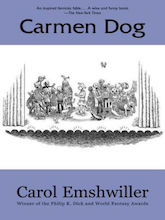

Carmen Dog
In Carol Emshwiller’s picaresque adventure, women begin turning into animals and animals suddenly become women. Pooch, until recently a lovely golden setter, finds herself turning into an equally lovely woman, while her mistress is taking a turn for the snapping turtle. As a loose wolverine rages through the city streets, baffled men try to figure out what’s happening, baffled animals try to adjust to their new lives, and Pooch is forced to kidnap her mistress’ (human) baby and go on the lam to keep it safe from its turtle-mom’s jaws. But now that she’s human Pooch is just starting to figure out what she wants to do with her new life, and that doesn’t include acting as an adoptive mother—she wants to be an opera singer.
Carmen Dog deftly mixes anthropomorphic animals, feminist critique, and sharp humor into a cult class that inspired Pat Murphy and Karen Joy Fowler to create the James Tiptree Jr. Memorial Award.
La Planète des Singes by Pierre Boulle
Buy the Book
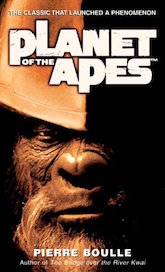

The Planet of the Apes
La Planète des Singes—in English, Planet of the Apes—has been adapted into three different film universes that riff on the book’s original premise: a far-future couple happen upon the writings of the human journalist Ulysse Mérou, who documents his time trapped in an off-planet ape society, dwelling on the way it stratifies itself between Gorilla, Orangutan, and Chimp. The 1960s films largely turn the discussion of class into one of racial discrimination, while the current film series shifts the primary focus onto animal rights. (The less said about the Tim Burton reboot, the better.) All versions also touch on the question of what makes us human, in large part by focusing on nuanced ape characters—from the scientifically-minded Zira and Cornelius, to the sympathetic Caesar.
Watership Down by Richard Adams
Buy the Book
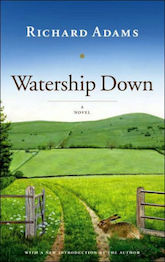

Watership Down
Possibly the most traumatic single book on a list of traumatic books, this is an epic adventure starring rabbits. Watership Down began life as a story Richard Adams told to his daughters, but with research he expanded into an epic the echoes the stories of Ulysses and Aeneas. Fiver, a psychic rabbit, has a vision that his warren is going to be destroyed. Only a few rabbits—including his brother Hazel—believe him, embarking together on a quest to find a new home, facing many dangers along the way. Finally, they reach the Watership Down of the title, set up camp, and begin exploring the possibilities of liberating some does from a nearby hutch. The only problem is, the powerful warren next door might try to take it from them… hence horrifying RABBIT WARFARE. Richard Adams rejects the idea that the story is an allegory, but it does act as a commentary on political and military struggles, and the ways a society that focuses on military might to the exclusion of all else might not be the best society, for rabbit or man.
Maus by Art Spiegelman
Buy the Book
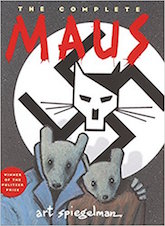

The Complete Maus: A Survivor's Tale
On second thought, maybe this is the most traumatic book on this list… In Maus, Art Spiegelman took his father’s stories of the Holocaust and recast them with talking animals: Jews = mice, Germans = cats, and Americans = dogs. This manages to both make the story more immediately readable, and somehow even more horrific, especially when you realize that Spiegelman was drawing on real Nazi imagery that cast Jews as a plague of rats, and that Zyklon B was initially manufactured as a pesticide. This book more than any other convinced a generation of non-comics readers that maybe the medium was something they should take seriously, paving the way for the graphic novel boom of the 1990s and beyond.
Earlier versions of this list were published in November 2015 and January 2018










